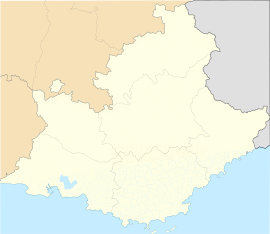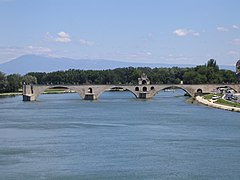Avignon: Commune in Vaucluse, France
Avignon (Latin: Avenio; Occitan: Avinhon) is a commune in southeastern France in the department of Vaucluse on the left bank of the Rhône river.
It is the capital (prefecture) of the Vaucluse department.
Avignon | |
|---|---|
Prefecture and commune | |
| From top: Skyline, Rocher des Doms, Palais des Papes, Avignon Cathedral, Festival d'Avignon, Pont Saint-Bénézet | |
| Coordinates: 43°57′N 4°49′E / 43.95°N 4.81°E | |
| Country | France |
| Region | Provence-Alpes-Côte d'Azur |
| Department | Vaucluse |
| Arrondissement | Avignon |
| Canton | Avignon-1, Avignon-2, Avignon-3 |
| Intercommunality | CA Grand Avignon |
| Government | |
| • Mayor (2014–2020) | Cécile Helle (PS) |
| Area 1 | 64.78 km2 (25.01 sq mi) |
| Population (2015) | 92,130 |
| • Density | 1,400/km2 (3,700/sq mi) |
| Time zone | UTC+01:00 (CET) |
| • Summer (DST) | UTC+02:00 (CEST) |
| INSEE/Postal code | 84007 /84000 |
| Elevation | 10–122 m (33–400 ft) (avg. 23 m or 75 ft) |
| Official name | Historic Centre of Avignon: Papal Palace, Episcopal Ensemble and Avignon Bridge |
| Criteria | Cultural: i, ii, iv |
| Reference | 228 |
| Inscription | 1995 (19th Session) |
| Area | 8.2 ha |
| 1 French Land Register data, which excludes lakes, ponds, glaciers > 1 km2 (0.386 sq mi or 247 acres) and river estuaries. | |
The historical centre, which includes the Palais des Papes, the cathedral, and the Pont d'Avignon, became a UNESCO World Heritage Site in 1995. The medieval monuments and the annual Festival d'Avignon have helped to make the town a major centre for tourism.
Name
The earliest forms of the name were reported by the Greeks:
- Аὐενιὼν = Auenion
- Άουεννίων = Aouennion (Ptolemy II, x).
The Roman name Avennĭo Cavarum (Mela, II, 575, Pliny III, 36), i.e. "Avignon of Cavares" shows that Avignon was one of the three cities of the tribe of Cavares, along with Cavaillon and Orange.
History
Between 1309 and 1377, during the Avignon Papacy, seven successive popes lived in Avignon and in 1348 Pope Clement VI bought the town from Joanna I (Italian: Giovanna I; March 1328 – 27 July 1382) was Queen of Naples and Countess of Provence.
Papal control persisted until 1791 when, during the French Revolution, it became part of France.
Geography
Avignon is on the left bank of the Rhône river, a few kilometres above its confluence with the Durance, about 580 km (360 mi) southeast of Paris, 229 km (142 mi) south of Lyon and 85 km (53 mi) northwest of Marseille.
It has an area of 64.78 km2 (25.01 sq mi) and its average altitude is 66 m (217 ft); at the city hall, the altitude is 19 m (62 ft).
 |
On the west Avignon shares a border with the department of Gard and to the south it borders the department of Bouches-du-Rhône.
Avignon is surrounded by the communes Sorgues, Le Pontet, Vedène, Morières-lès-Avignon and Caumont-sur-Durance and the departments Bouches-du-Rhône (communes of Noves, Châteaurenard, Rognonas and Barbentane) and Gard (communes of Les Angles and Villeneuve-lès-Avignon).
The Rhône, the Durance (tributary of the Rhône) and the L'Anguillon (tributary of the Durance) are the rivers flow through the commune.
The Rhône passes the western edge of the city but is divided into two branches: the Petit Rhône for the part that passes next to Avignon, and the Grand Rhône for the western channel which passes Villeneuve-lès-Avignon in the Gard department. The two branches are separated by an island, the Île de la Barthelasse.
The Durance flows along the southern boundary of the commune into the Rhône and marks the departmental boundary with Bouches-du-Rhône.
Climate
The climate of Avignon, in the Köppen climate classification, is Csa - Oceanic climate with hot summers.
The average temperature for the year in Avignon is 14.4 °C (57.9 °F). The warmest month, on average, is July with an average temperature of 23.3 °C (73.9 °F). The coolest month on average is January, with an average temperature of 5 °C (41 °F).
The average amount of precipitation for the year in Avignon is 617.2 mm (24.3 in). The month with the most precipitation on average is October with 83.8 mm (3.3 in) of precipitation. The month with the least precipitation on average is January with an average of 22.9 mm (0.9 in).
| Climate data for Avignon, France | |||||||||||||
|---|---|---|---|---|---|---|---|---|---|---|---|---|---|
| Month | Jan | Feb | Mar | Apr | May | Jun | Jul | Aug | Sep | Oct | Nov | Dec | Year |
| Average high °C (°F) | 9 (48) | 11 (52) | 15 (59) | 19 (66) | 23 (73) | 27 (81) | 30 (86) | 30 (86) | 25 (77) | 20 (68) | 13 (55) | 10 (50) | 19 (67) |
| Daily mean °C (°F) | 5 (41) | 6 (43) | 10 (50) | 13 (55) | 16 (61) | 20 (68) | 23 (73) | 22 (72) | 19 (66) | 14 (57) | 9 (48) | 6 (43) | 14 (56) |
| Average low °C (°F) | 1 (34) | 2 (36) | 5 (41) | 7 (45) | 10 (50) | 14 (57) | 16 (61) | 15 (59) | 13 (55) | 9 (48) | 5 (41) | 2 (36) | 8 (47) |
| Average rainfall mm (inches) | 20 (0.8) | 30 (1.2) | 40 (1.6) | 50 (2.0) | 60 (2.4) | 40 (1.6) | 30 (1.2) | 40 (1.6) | 60 (2.4) | 80 (3.1) | 70 (2.8) | 50 (2.0) | 570 (22.7) |
| Source: Weatherbase.com [1] | |||||||||||||
Population
The inhabitants of Avignon are known, in French, as Avignonnais (women: Avignonnaises).
With a population of 92,209, Avignon has a population density of 1,423 inhabitants/km2.
Evolution of the population in AvignonT

Transport
Rail
Avignon has three train stations: Gare d'Avignon Centre, Gare d'Avignon TGV and Gare d'Avignon-Montfavet.
Administration
Avignon is the prefecture of the Vaucluse department since 1793. It is also the capital of the arrondissement of Avignon and the administrative centre (French: chef-lieu) of three cantons, all formed with part of the commune:
- Avignon-1 : 30,134 inhabitants (2014)
- Avignon-2 : 34,426 inhabitants (2014)
- Avignon-3 : 35,749 inhabitants (27,649 in Avignon and 8,100 in Morières-lès-Avignon) (2014)
It is part of the intercommunality Grand Avignon (French: Communauté d'agglomération du Grand Avignon).
Sister cities
Avignon is twinned with:
Places of interest
Some interesting places in Avignon are:
Gallery
- The Pont d'Avignon with Mont Ventoux in the background.
- Palais des Papes and the cathedral.
- Historical centre of Avignon
Related pages
References
Other websites

- Ville de Avignon - official website (in French)
- Avignon Tourist Office Archived 2017-04-23 at the Wayback Machine
- Avignon greater metropolitan area website Archived 2017-02-05 at the Wayback Machine (in French)
- Avignon theatre festival website (in French)
This article uses material from the Wikipedia Simple English article Avignon, which is released under the Creative Commons Attribution-ShareAlike 3.0 license ("CC BY-SA 3.0"); additional terms may apply (view authors). Content is available under CC BY-SA 4.0 unless otherwise noted. Images, videos and audio are available under their respective licenses.
®Wikipedia is a registered trademark of the Wiki Foundation, Inc. Wiki Simple English (DUHOCTRUNGQUOC.VN) is an independent company and has no affiliation with Wiki Foundation.


















